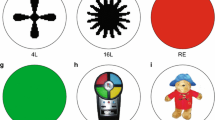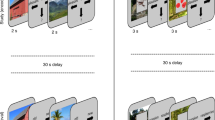Abstract
In order to analyse how hippocampal activity is related to memory, the activity of single hippocampal neurons was recorded while macaques performed a recognition memory task. In the task, the first time a stimulus was shown, no reward could be obtained, and the second time a visual stimulus was shown, the monkeys could lick to obtain fruit juice. Many other stimuli could intervene between the novel and familiar presentations of each stimulus. Of 660 neurons analysed, 15 (2.3%) responded differently to novel and to familiar stimuli, with the majority of these responding more to novel than to familiar stimuli. The latencies of the differential responses of the neurons were typically in the range 140–260 ms. The responses of these neurons reflected whether a visual stimulus had been seen recently, in that the neurons responded differently to novel and familiar presentations of a stimulus when a median of 21 other stimuli intervened between the novel and familiar presentations. The responses of these neurons were shown to be related to whether the stimuli had been seen before, not to the reinforcement or the lick responses made, in that the neurons did not have comparable responses in a visual discrimination task in which licks were made to a rewarding stimulus but not to another stimulus. It is concluded that the activity of a small but significant proportion of hippocampal neurons is related to whether a stimulus has been seen before recently, and that this processing is likely to be involved in memory.
Similar content being viewed by others
References
Aggleton JP, Passingham RE (1981) Stereotaxic surgery under X-ray guidance in the rhesus monkey, with special reference to the amygdala. Exp Brain Res 44:271–276
Baylis GC, Rolls ET (1987) Responses of neurons in the inferior temporal cortex in short term and serial recognition memory tasks. Exp Brain Res 65:614–622
Cahusac PMB, Miyashita Y, Rolls ET (1989) Responses of hippocampal formation neurons in the monkey related to delayed spatial response and object-place memory tasks. Behav Brain Res 33:229–240
Feigenbaum JD, Rolls ET (1991) Allocentric and egocentric spatial information processing in the hippocampal formation of the behaving primate. Psychobiol 19:21–40
Fuster JM, Jervey JP (1982) Neuronal firing in the inferotemporal cortex of the monkey in a visual memory task. J Neurosci 2:361–375
Gaffan D (1974) Recognition impaired and association intact in the memory of monkeys after transection of the fornix. J Comp Physiol Psychol 86:1100–1109
Gaffan D (1977) Monkey's recognition memory for complex pictures and the effects of fornix transection. Q J Exp Psychol 29:505–514
Gaffan D, Weiskrantz L (1980) Recency effects and lesion effects in delayed non-matching to randomly baited samples by monkeys. Brain Res 196:373–386
Gaffan D, Saunders RC (1985) Running recognition of configural stimuli by fornix transected monkeys. Q J Exp Psychol 37B: 61–71
Gaffan D, Harrison S (1989) A comparison of the effects of fornix section and sulcus principalis ablation upon spatial learning by monkeys. Behav Brain Res 31:207–220
Gaffan D, Saunders RC, Gaffan EA, Harrison S, Shields C, Owen MJ (1984a) Effects of fornix transection upon associative memory in monkeys: role of the hippocampus in learned action. Q J Exp Psychol 26B: 173–221
Gaffan D, Gaffan EA, Harrison S (1984b) Effects of fornix transection on spontaneous and trained non-matching by monkeys. Q J Exp Psychol 36B: 285–303
Heit G, Smith ME, Halgren E (1988) Neural encoding of individual words and faces by the human hippocampus and amygdala. Nature 333:773–775
Merrill EG, Ainsworth A (1972) Glass-coated platinum-plated tungsten microelectrodes. Med Biol Eng 10:662–672
Milner B (1972) Disorders of learning and memory after temporal lobe lesions in man. Clin Neurosurg 19:421–446
Miyashita Y, Chang HS (1988) Neuronal correlate of pictorial short-term memory in the primate temporal cortex. Nature 331:68–70
Miyashita Y, Rolls ET, Cahusac PMB, Niki H, Feigenbaum JD (1989) Activity of hippocampal neurons in the monkey related to a conditional spatial response task. J Neurophysiol 61:669–678
Murray EA, Bachevalier J, Mishkin M (1989) Effects of rhinal cortical lesions on visual recognition memory in rhesus monkeys. Soc Neurosci Abstr 15:342
Owen MJ, Butler SR (1981) Amnesia after transection of the fornix in monkeys: long-term memory impaired, short-term memory intact. Behav Brain Res. 3:115–123
Parkinson JK, Murray EA, Mishkin M (1988) A selective mnemonic role for the hippocampus in monkeys: memory for the location of objects. J Neurosci 8:4059–4067
Petrides M (1985) Deficits on conditional associative-learning tasks after frontal- and temporal-lobe lesions in man. Neuropsychologia 23:601–614
Riches IP, Wilson FAW, Brown MW (1991) The effects of visual stimulation and memory on neurones of the hippocampal formation and the neighbouring parahippocampal gyrus and inferior temporal cortex of the primate. J Neurosci 11:1763–1769
Rolls ET (1987) Information representation, processing and storage in the brain: analysis at the single neuron level. In: Changeux J-P, Konishi M (eds) The neural and molecular bases of learning. Wiley, Chichester, pp 503–540
Rolls ET (1989a) Functions of neuronal networks in the hippocampus and neocortex in memory. In: Byrne, JH, Berry, WO (eds) Neural models of plasticity: experimental and theoretical approaches. Academic Press, San Diego, pp 240–265
Rolls ET (1989b) The representation and storage of information in neuronal networks in the primate cerebral cortex and hippocampus. In: Durbin R, Miall C, Mitchison G (eds) The Computing Neuron. Addison-Wesley, Wokingham, England, pp 125–159
Rolls ET (1990) Functions of the primate hippocampus in spatial processing and memory. In: Olton DS, Kesner, RP (eds) Neuro-biology of comparative cognition. Erlbaum, Hillsdale, NJ, pp 339–362
Rolls ET (1991) Functions of the primate hippocampus in spatial and non-spatial memory. Hippocampus 1:258–261
Rolls ET, Treves A (1990) The relative advantages of sparse versus distributed encoding for associative neuronal networks in the brain. Network 1:407–421
Rolls ET, O'Mara S (1993) Neurophysiological and theoretical analysis of how the hippocampus functions in memory. In: Ono T, Squire LR, Raichle M, Perrett D, Fukuda M (eds) Brain mechanisms of perception: from neuron to behavior. Oxford University Press, New York
Rolls ET, Burton MJ, Mora F (1976) Hypothalamic neuronal responses associated with the sight of food. Brain Res 111:53–66
Rolls ET, Sanghera MK, Roper-Hall A (1979) The latency of activation of neurones in the lateral hypothalamus and substantia innominata during feeding in the monkey. Brain Res 164:121–135
Rolls ET, Perrett DI, Caan AW, Wilson FAW (1982) Neuronal responses related to visual recognition. Brain 105:611–646
Rolls ET, Miyashita Y, Cahusac PMB, Kesner RP, Niki H, Feigenbaum J, Bach L (1989) Hippocampal neurons in the monkey with activity related to the place in which a stimulus is shown. J Neurosci 9:1835–1845
Rupniak NMJ, Gaffan D (1987) Monkey hippocampus and learning about spatially directed movements. J Neurosci 7:2331–2337
Schwartz EL, Desimone R, Albright TD, Gross CG (1983) Shape recognition and inferior temporal neurons. Proc Natl Acad Sci USA 80:5776–5778
Scoville WB, Milner B (1957) Loss of recent memory after bilateral hippocampal lesions. J Neurol Neurosurg Psychiatry 20:11–21
Smith ML, Milner B (1981) The role of the right hippocampus in the recall of spatial location. Neuropsychologia 19:781–793
Squire LR (1992) Memory and the hippocampus: a synthesis from findings with rats, monkeys and humans. Psychol Rev 99:195–231
Squire LR, Shimamura AP, Amaral DG (1989) Memory and the hippocampus. In: Byrne J, Berry WO (eds) Neural models of plasticity: theoretical and empirical approaches. Academic Press, New York, pp 208–239
Treves A, Rolls ET (1991) What determines the capacity of autoassociative memories in the brain? Network 2:371–397
Wilson FAW, Rolls ET (1993) The effects of stimulus novelty and familiarity on neuronal activity in the amygdala of monkeys performing recognition memory tasks. Exp Brain Res (in press)
Woodward RH, Goldsmith PL (1964) Cumulative sum techniques: mathematical and statistical techniques for industry. ICI Monograph No. 3, Oliver and Boyd, Edinburgh
Zola-Morgan S, Squire LR (1985) Medial temporal lesions in monkeys impair memory in a variety of tasks sensitive to human amnesia. Behav Neurosci 99:22–34
Zola-Morgan S, Squire LR, Amaral DG (1986) Human amnesia and the medial temporal region: enduring memory impairment following a bilateral lesion limited to field CA1 of the hippocampus. J Neurosci 6:2950
Zola-Morgan S, Squire LR, Amaral DG (1989a) Lesions of the amygdala that spare adjacent cortical regions do not impair memory or exacerbate the impairment following lesions of the hippocampal formation. J Neurosci 9:1922–1936
Zola-Morgan S, Squire LR, Amaral DG, Suzuki WA (1989b) Lesions of perirhinal and parahippocampal cortex that spare the amygdala and hippocampal formation produce severe memory impairment. J Neurosci 9:4355–4370
Author information
Authors and Affiliations
Rights and permissions
About this article
Cite this article
Rolls, E.T., Cahusac, P.M.B., Feigenbaum, J.D. et al. Responses of single neurons in the hippocampus of the macaque related to recognition memory. Exp Brain Res 93, 299–306 (1993). https://doi.org/10.1007/BF00228398
Received:
Accepted:
Issue Date:
DOI: https://doi.org/10.1007/BF00228398




